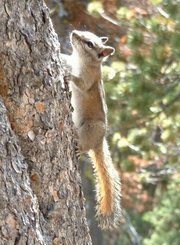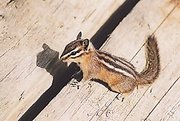Chipmunk
Chipmunk is the common name for any small squirrel-like rodent species of the genus Tamias in the family Sciuridae. more...
About 23 species fall under this title, with one species in northeastern Asia, one in the eastern portions of Canada and the US, and all the rest native to the western part of North America.
The name stems from the loud chip sound that they make, in addition to a rapid trill sound. They are also called striped squirrel or ground squirrel; however, the name "ground squirrel" is more usually kept for the genus Spermophilus, though Tamias and Spermophilus are only two of the 13 genera of ground-living sciurids.
Though they are commonly depicted with their paws up to the mouth, eating peanuts, or more famously their cheeks bulging out on either side, chipmunks eat a much more diverse range of foods than just nuts. Their omnivorous diet consists of grain, nuts, birds' eggs, fungi, and insects. Come autumn, many species of chipmunk begin to stockpile these goods in their burrows, for winter. Other species make multiple small caches of food. These two kinds of behavior are called larder hoarding and scatter hoarding. Larder hoarders usually live in their nests until spring.
These small squirrels fulfill several important functions in forest ecosystems. Their activities with regards to harvesting and hoarding tree seeds play a crucial role in seedling establishment. They also consume many different kinds of fungi, including those involved in symbiotic mycorrhizal associations with trees, and are an important vector for dispersal of the spores of subterranean sporocarps (truffles) which have co-evolved with these and other mycophagous mammals and thus lost the ability to disperse their spores through the air.
Chipmunks play an important role as prey for various predatory mammals and birds, but are also opportunistic predators themselves, particularly with regard to bird eggs and nestlings. In Oregon, Mountain Bluebirds (Siala currucoides) have been observed energetically mobbing chipmunks that they see near their nest trees.
Chipmunks construct expansive burrows which can be more than 3.5 m in length with several well-concealed entrances. The sleeping quarters are kept extremely clean as shells and feces are stored in refuse tunnels.
If unmolested they often become bold enough to accept food from the hands of humans. The temptation to pick up or pet any wild animal should be strictly avoided. While rabies is exceptionally rare, if non-existent, in rodents, chipmunk bites can transmit virulent and dangerous bacterial infections.
Species
- Alpine Chipmunk, Tamias alpinus
- Yellow pine Chipmunk, Tamias amoenus
- Gray-footed Chipmunk, Tamias canipes
- Gray-Collared Chipmunk, Tamias cinereicollis
- Cliff Chipmunk, Tamias dorsalis
- Merriam's Chipmunk, Tamias merriami
- Least Chipmunk, Tamias minimus
- California Chipmunk, Tamias obscurus
- Yellow-cheeked Chipmunk, Tamias ochrogenys
- Palmer's Chipmunk, Tamias palmeri
- Panamint Chipmunk, Tamias panamintinus
- Long-eared Chipmunk, Tamias quadrimaculatus
- Colorado Chipmunk, Tamias quadrivittatus
- Red-Tailed Chipmunk, Tamias ruficaudus
- Hopi Chipmunk, Tamias rufus
- Allen's Chipmunk, Tamias senex
- Siberian Chipmunk, Tamias sibiricus
- Siskiyou Chipmunk, Tamias siskiyou
- Sonoma Chipmunk, Tamias sonomae
- Lodgepole Chipmunk, Tamias speciosus
- Eastern Chipmunk, Tamias striatus
- Townsend's Chipmunk, Tamias townsendii
- Uinta Chipmunk, Tamias umbrinus
Read more at Wikipedia.org



